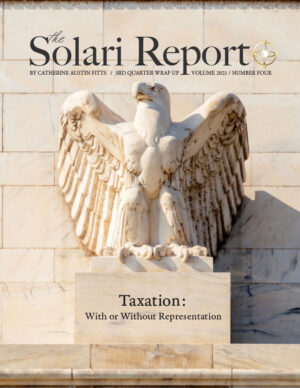Listen to the MP3 audio file
The Solari Report – 18 June 2009
Download the MP3 audio file
I was speaking with an energetic healer this week and mentioned that the shock doctrine is about to roll out in the United States, starting with California. She said, “looks like we need Grizzly Bear magic,” referring to the grizzly bear in the California state flag.
On this week’s Solari Report, I will be reviewing what is happening in California and how citizens can take action to prepare themselves. The banks are now flush with cash and some of them are out from under government restrictions. A great deal of money has been amassed. Will they finance real estate developers on a shopping spree for state parks and facilities? Will a wider understanding of California’s situation put additional pressure on the Treasury bond market and the dollar globally?
In the meantime, best to be prepared for what several budget cycles of severe state and local budget cuts could mean – whether to local services, the economy, or the municipal bond markets. This month, Californians are most at risk. However, the U.S. state and local government budget crunch is a financial wave coming to your door. This wave will have a dramatic impact on most North Americans and could fundamentally alter the relationship of American states with the federal government. This wave will reach beyond North America, impacting the global economy in significant ways.
This week’s Solari Report will come to you from Tucson, Arizona where I will be speaking at the Institute of Noetic Sciences conference. I will cover other developments in our extended segment of Money and Markets, answer questions in Ask Catherine, and then address the California situation.
In our Let’s Go To the Movies segment, I will review Welcome to Mooseport, a comedy in which Gene Hackman, the retiring President of the United States, runs for Mayor in Mooseport, Maine and gets an education in the intimate issues of local governance and budgets.
If you are a subscriber to The Solari Report, you can post your questions at your private panel or feel free to also post them at this blog post. If you would like to learn more about The Solari Report and subscribe, click here.
_/_/_/_/_/_/_/_/_/_/_/_/_/



 3rd Quarter 2022 Wrap Up: Building Wealth (80 pages)
3rd Quarter 2022 Wrap Up: Building Wealth (80 pages)  Women in Art (254 pages)
Women in Art (254 pages)  3rd Quarter 2021 Wrap Up: Taxation - With or Without Representation (172 pages)
3rd Quarter 2021 Wrap Up: Taxation - With or Without Representation (172 pages)
California is much bigger than Guernsey Island, yet cannot use Guernsey’s simple example as a way out of crisis.
Oakland has to submit a 5-year plan to get “Federal” money -which COULD be simply created for the purpose, had central bankers not long ago won that long fight for monopoly on money creation.
That monopoly is the cause of crises such as the current ones. Most people don’t understand it but it’s deceptively simple: Human endeavor & interaction is mostly governed by money, and money is a magical device whose power has been usurped to serve a power elite. Crisis can easily be engineered to further consolidate power, and it is happening all around us.
Instead of going further in the hole by issuing IOUs, California could be issuing its own money, debt free, and creating out of this crisis a new prosperity, as was done on Guernsey and numerous other examples in history. But of course this possibility has been pre-empted. Money itself now rules. Corporations are soul-less instruments of the artificial system of values money has become. Corporations are immortal and powerful with privileges and rights beyond those of humans. Humans can only serve this crass and destructive agenda or dry up for lack of funding.
The task is not to find humans to blame, but to understand the problem as an artificial one, created by humans YES, but now no longer beholden to human values. Humans could yet kill the beast, but that would require agreement as to what the beast actually IS. The beast is our beastly debt-money system, pure & simple. The governator may not even realize he is a pawn of that system, owing his privilege to his willingness to do its bidding.
Ahnahld, you’ve been a POS gubernator.
How can we terminate you?
This from a letter to the editor today in the Marin newspaper; worth typing
out here.
Writer is saying that closing the parks makes no sense financially:
“The general fund budget for our state parks, already cut to the bone,
accounts for less than one-tenth of 1 percent of the state budget.
“Yet for every dollar that funds the parks, $2.35 is returned to the
state’s general fund through economic activities in all the surrounding
communities.
“With more than 80 million visitors to our state parks last year alone,
eliminating funding for the parks could result in the state losing over $359
million in related revenue.
“Economic downturn” is not an acceptable reason Before we squander our
state’s priceless resources — already paid for by our tax dollars — we should
look at less destructive was to economize.
“Two easy examples: The extra per diem and car allowances of our
legislators, and the flagrant waste and overbilling in our state’s prison system.”
well, we have all the facts. but what action can citizens take? we need to be protesting in a big way. demonstrate numbers and discontent with this process of public rip-off.
For numerous links that will help collect data on a place or map out your local financial ecosystems, including state and local government, see the GET DATA links on the right of this blog, or other ideas available here:
http://www.ratical.org/co-globalize/savingTenn.html
LINKS TO FINANCIAL DATA IN CALIFORNIA
FEDERAL GOVERNMENT
Agricultural Subsidies
http://farm.ewg.org/farm/index.php?key=nosign
STATE OF CALIFORNIA
California Budget 101: Making sense of the state’s financial meltdown
http://www.mercurynews.com/breakingnews/ci_12579720
California Nears Financial “Meltdown” as Revs Tumble; Reuters (10 June 09)
http://www.reuters.com/article/newsOne/idUSTRE55974820090610
California’s bond ratings don’t reflect reality (LA Times, 3/26/09)
http://www.latimes.com/news/local/la-me-cap26-2009mar26,0,7033993.column
California Recovery Act spending
http://www.recovery.ca.gov/
Official state website
http://www.ca.gov/
State agency contracts database search tool
http://www.bidsync.com/DPX?ac=agencycontlist&foroid=307818
State parks
http://www.parks.ca.gov/
Regional maps
http://www.visitcalifornia.com/AM/Template.cfm?Section=Maps&Template=/TaggedPage/TaggedPageDisplay.cfm&TPLID=11&ContentID=4740&cttcTemplate=traveltools/Maps/
School data finder tool
http://dq.cde.ca.gov/dataquest/
Department of Health Care Services (includes links to # Department of Health Care Services Budget Balancing Reductions – Local Assistance; Department of Health Care Services Budget Balancing Reductions – State Operations; 2009-10 Governor’s Budget Highlights DHCS and ARRA summary)
http://www.dhcs.ca.gov/Pages/default.aspx
MediCal website
http://www.dhcs.ca.gov/services/medi-cal/Pages/default.aspx
State Treasurer’s website
http://www.treasurer.ca.gov/
Bonds and public financing
http://www.treasurer.ca.gov/
Bond sale database
http://www.treasurer.ca.gov/cdiac/database.asp
Buy California bonds (current offerings)
http://www.buycaliforniabonds.com/bcb.asp
On-line campaign finance and lobbying disclosure reports
http://cal-access.ss.ca.gov/
Fair Political Practices Commission
http://www.fppc.ca.gov/
CALIFORNIA PENSION FUNDS
CalPERS Investment Reports
http://www.calpers.ca.gov/index.jsp?bc=/investments/reports/home.xml
California State Teachers Retirement System
http://www.calstrs.com/
California Retired Teachers Association
http://www.calrta.org/NewsEvents.php?id=32&cat_id=7
CalPERS
http://www.calpers.ca.gov/
COMPREHENSIVE ANNUAL FINANCIAL REPORTS – SELECTED CITIES
City of Berkeley CAFR
http://www.ci.berkeley.ca.us/ContentDisplay.aspx?id=7760
The CAFR includes the City’s financial position and results of operations. It also contains demographic and statistical information to help the reader understand the financial condition of the City for each fiscal year. The current CAFR is for the City’s 2008 fiscal year, which ended June 30, 2008.
CITY OF OAKLAND
Budget woes have Oakland mulling bankruptcy
http://www.sfgate.com/cgi-bin/article.cgi?f=/c/a/2009/06/09/BARI183DJB.DTL&type=newsbayarea
City of Oakland official website (includes proposed city budgets, Opportunities for Public Input to FY 2009-11 Budget and information on City of Oakland Special Municipal Vote by Mail Election – July 21)
http://www.oaklandnet.com/
Online Portal to City Council and Council Committees Legislative Activity.
http://clerkwebsvr1.oaklandnet.com/mattersearch/home.aspx
City of Oakland Bonds (includes links to summary of debt outstanding and official statements)
http://www.oaklandnet.com/government/fwawebsite/treasury/treasury_home.htm
City and Agency Resolutions Authorizing the City Administrator to Execute a
Two (2) Year Professional Services Contract Between the City of Oakland and
Macias, Gini & O’Connell, LLP to Provide Audit Services for the Fiscal Year
Ending June 30, 2008 in the Amount Not To Exceed $694,275, and Fiscal Year
Ending June 30, 2009 in the Amount Not To Exceed $728,989.
clerkwebsvr1.oaklandnet.com/attachments/18716.pdf
Alameda County official website
http://www.acgov.org/
Alameda County Board of Supervisors
http://www.acgov.org/board/index.htm
Alameda County Ordinances and Administrative Code
http://www.acgov.org/government/admincode.htm
Alameda County Departments and Agencies
http://www.acgov.org/government/departments.htm
Alameda County Comprehensive Annual Report
http://www.acgov.org/auditor/cafr.htm
Alameda County contracting opportunities database
http://www.acgov.org/gsa_app/gsa/purchasing/bid_content/contractopportunities.jsp
Alameda County public works (includes development stage projects and various annual reports)
http://www.acgov.org/pwa/
Alameda County Small Business Development Center
http://acsbdc.org/
East Bay Metropolitan Utility District
http://www.ebmud.com/
Alameda County Employee Retirement System
http://www.acera.org/index.php
* * * *
Oakland Consolidated Plan submitted to HUD
http://www.oaklandnet.com/
Included are:
Official Plans
* Consolidated Plans
o Current Plans
o Citizen Participation Plan
o Fair Housing Plans
o Older Consolidated Plans (2000-2005)
* Housing Element
* AIDS Housing Plan
Policies & Strategies
Municipal Codes & Ordinances
Housing and Community Development Consolidated Plans
The City of Oakland is required to submit a 5-Year Consolidated Plan, as well as annual Action Plans and Performance Reports to the U.S. Department of Housing and Urban Development (HUD) in order to receive funds from the Community Development Block Grant, HOME Investment Partnership, Emergency Shelter Grant, and Housing Opportunities for Persons with AIDS grants.
The 5-year plan includes information on housing needs, resources, and strategies.
The annual action plans include information on specific activities funded with CDBG and other federal funds, as well as housing activities carried out with other funds.
* * * *
MORE CALIF. CONSPIRACY THEORIES FROM http://www.anewwayforward.org (link broken) :
1. The Ugly Agenda Behind California?s Budget Crisis (Michael)
2. Fwd: [realbankreform] Americans for Financial Reform Launch
Campaign to Clean Up Wall Street, Protect Your Pocketbook
(tiffiniy cheng`)
Subject: [Discussion] The Ugly Agenda Behind California?s Budget
Crisis
This article was posted to LeagueDiscuss. It takes the analysis from
Naomi Kleins book Shock Doctrine and applies it to the budget crises
in California and the general crises of capitalism we are living thru.
Michael/Detroit
Steven Miller
June 15, 2009
The Ugly Agenda Behind California?s Budget Crisis
Once economic crisis gets snarled up and aggravated it often can no
longer be resolved by economic means. Then a political crisis emerges
as economic classes seek to determine a political resolution to the
crisis. By definition, politics is about the struggle for power ? to
control what happens ? and no force is larger in that struggle than
classes.
The French Revolution was the classic example. It was precipitated by
a long drawn-out budget and tax crisis. Every class, including the
king, was in favor of taxation, but nobody could figure how to raise
taxes without trampling on the hallowed privileges of each estate. The
months of stasis lead to increasing suffering, until women
demonstrating at Versailles just decided to kidnap the king. Then
things jumped off. Suddenly the budget crisis was subsumed by politics
as the newly wealthy bourgeoisie took over and changed everything.
The economics of California?s budget crisis are fundamentally
different, but the nexus of events is pushing political resolution
onto the stage. At one level, the state?s crisis is a classic ?Shock?
straight out of the pages of Naomi Klein?s important book The Shock
Doctrine. As we will see below, the so-called $24.3 budget crisis is
completely manufactured, a direct and deliberate result of policies
embraced by both Democrats and Republicans.
California?s crisis is deliberately engineered by corporations. We all
remember the last manufactured crisis – the state?s 1999 ?Electrical
Crisis? – that was engineered by ENRON and various hedge funds in
order to make a hostile takeover of the state?s electrical grid. That
little crisis cost the state some $40 billion, money that is still
being paid off.
Klein describes how the neo-liberal economic system (ie the global
capitalist financial system) created economic crises across the world
in order to take advantage of them and privatize public services. She
shows in detail how the Bush Administration outsourced the public
services of the US government and essentially privatized their delivery.
Governor Schwarzenegger has already illegally seized some $5 billion
from the state?s public schools. Now he is demanding $4 billion more.
This plays right into the hands of privatizers like Eli Broad and
Steve Barr of Green Dot Charters.
On a more profound level, the crisis is being driven by the same
objective forces that have created the world financial meltdown. This
crisis is a classic overproduction crisis. In this case, so many
houses were created that people could no longer buy them, so predatory
loans were offered to sucker poor people into thinking that they could
get into a home with no money down. Then mortgages were
?securitized? (ie – turned into investment opportunities) that feed a
speculative bubble. These scams happened more in California than any
other state.
The whole economy is increasingly formatted so that the vastly
powerful organizations of speculative capital can ?securitize?
everything, from health care to water to public education, making the
necessities of life into the fodder for billion-dollar bets on the
stock market.
This process drives the government to serve the speculators, as has so
conveniently been done with the federal bailouts that now total $12.6
trillion and climbing ? all in the last 18 months. At every level ?
federal, state and local ? governments are proclaiming the need to get
out of the business of helping people. Social services are privatized
and farmed out to corporations, who take their profit off the top.
First New Orleans, then Detroit. Now California.
The coming privatization of public infrastructure and municipal
services is described by ecologist Jo-Sing Yang in November 2008 (www.alternet.org/story/105083/
legalize pot in Calif. state run stores like in
Canada!
Buy-Gold!!!